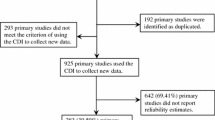Abstract
The study examines the validity and reliability of the Danish version of the Children’s Depression Inventory (CDI) in a child psychiatric population. Participants were 149 child psychiatric patients aged 8–13 and their parents. After diagnostic interview with the Kiddie-Schedule for Affective Disorders and Schizophrenia, the children completed the CDI. A subgroup of 44 children repeated the CDI after 2 weeks. The psychometric properties of the Danish CDI were similar to those reported for the English version. CDI is moderately correlated with other measures for depressive disorder, but the instrument is not sufficiently reliable or valid to be used as a single diagnostic or screening measure in a child psychiatric population.
Similar content being viewed by others
References
Bland JM,Altman DG (1986) Statistical methods for assessing agreement between two methods of clinical measurement. Lancet 1:307–310
Brooks SJ, Kutcher S (2001) Diagnosis and measurement of adolescent depression: a review of commonly utilized instruments. J Child Adolesc Psychopharmacol 11:341–376
Carey MP, Faulstich ME, Gresham FM, Ruggiero L, Enyart P (1987) Children’s Depression Inventory: construct and discriminant validity across clinical and nonreferred (control) populations. J Consult Clin Psychol 55:755–761
Costello EJ, Angold A, Burns BJ, Stangl DK, Tweed DL, Erkanli A, Worthman CM (1996) The Great Smoky Mountains Study of Youth. Goals, design,methods, and the prevalence of DSM-III-R disorders. Arch Gen Psychiatry 53:1129–1136
Flament MF, Cohen D, Choquet M, Jeammet P, Ledoux S (2001) Phenomenology, psychosocial correlates, and treatment seeking in major depression and dysthymia of adolescence. J Am Acad Child Adolesc Psychiatry 40:1070–1078
Fristad MA, Emery BL, Beck SJ (1997) Use and abuse of the Children’s Depression Inventory. J Consult Clin Psychol 65:699–702
Ialongo NS, Edelsohn G, Kellam SG (2001) A further look at the prognostic power of young children’s reports of depressed mood and feelings. Child Dev 72:736–747
Kaufman J, Birmaher B, Brent D, Rao U, Flynn C, Moreci P, Williamson D, Ryan N (1997) Schedule for Affective Disorders and Schizophrenia for School-Age Children-Present and Lifetime Version (K-SADS-PL): initial reliability and validity data. J Am Acad Child Adolesc Psychiatry 36:980–988
Kim YS, Cheon KA, Kim BN, Chang SA, Yoo HJ, Kim JW, Cho SC, Seo DH, Bae MO, So YK, Noh JS, Koh YJ, McBurnett K, Leventhal B (2004) The reliability and validity of Kiddie-Schedule for Affective Disorders and Schizophrenia-Present and Lifetime Version-Korean version (K-SADS-PL-K). Yonsei Med J 45:81–89
Knight D, Hensley VR, Waters B (1988) Validation of the Children’s Depression Scale and the Children’s Depression Inventory in a prepubertal sample. J Child Psychol Psychiatry 29:853–863
Kolvin I, Barrett ML, Bhate SR, Berney TP, Famuyiwa OO, Fundudis T, Tyrer S (1991) The Newcastle Child Depression Project. Diagnosis and classification of depression. Br J Psychiatry (Suppl):9–21
Kovacs M (1985) The Children’s Depression Inventory (CDI). Psychopharmacol Bull 21:995–998
Kovacs M (1992) Manual for the Children’s Depression Inventory. Multi-Health Systems, North Tonawanda, NJ
Landis JR, Koch GG (1977) The measurement of observer agreement for categorical data. Biometrics 33:159–174
Lewinsohn PM, Rohde P, Seeley JR, Klein DN, Gotlib IH (2003) Psychosocial functioning of young adults who have experienced and recovered from major depressive disorder during adolescence. J Abnorm Psychol 112:353–363
Lewinsohn PM, Solomon A, Seeley JR, Zeiss A (2000) Clinical implications of “subthreshold” depressive symptoms. J Abnorm Psychol 109:345–351
Liss H, Phares V, Liljequist L (2001) Symptom endorsement differences on the Children’s Depression Inventory with children and adolescents on an inpatient unit. J Pers Assess 76:396–411
Nelson WM III, Politano PM, Finch AJ Jr, Wendel N, Mayhall C (1987) Children’s Depression Inventory: normative data and utility with emotionally disturbed children. J Am Acad Child Adolesc Psychiatry 26:43–48
Nolen-Hoeksema S, Girgus JS, Seligman ME (1986) Learned helplessness in children: a longitudinal study of depression, achievement, and explanatory style. J Pers Soc Psychol 51:435–442
Ruscio AM, Ruscio J (2002) The latent structure of analogue depression: should the Beck Depression Inventory be used to classify groups? Psychol Assess 14:135–145
Saylor CF, Finch AJ Jr, Spirito A, Bennett B (1984) The children’s depression inventory: a systematic evaluation of psychometric properties. J Consult Clin Psychol 52:955–967
Seligman ME, Peterson C, Kaslow NJ, Tanenbaum RL, Alloy LB,Abramson LY (1984) Attributional style and depressive symptoms among children. J Abnorm Psychol 93:235–238
Shaffer D, Gould MS, Brasic J, Ambrosini P, Fisher P, Bird H, Aluwahlia S (1983) A children’s global assessment scale (CGAS). Arch Gen Psychiatry 40:1228–1231
Shanee N, Apter A, Weizman A (1997) Psychometric properties of the KSADS-PL in an Israeli adolescent clinical population. Isr J Psychiatry Relat Sci 34:179–186
Smucker MR, Craighead WE, Craighead LW, Green BJ (1986) Normative and reliability data for the Children’s Depression Inventory. J Abnorm Child Psychol 14:25–39
Sorensen MJ, Nissen JB, Mors O, Thomsen PH (2005) Age and gender differences in depressive symptomatology and comorbidity: an incident sample of psychiatrically admitted children. J Affect Disord 84:85–91
SPSS. Statistical Package for the Social Sciences. 2002. Chicago, SPSS inc. 1989
Timbremont B, Braet C, Dreessen L (2004) Assessing depression in youth: relation between the Children’s Depression Inventory and a structured interview. J Clin Child Adolesc Psychol 33:149–157
Twenge JM, Nolen-Hoeksema S (2002) Age, gender, race, socioeconomic status, and birth cohort differences on the children’s depression inventory: a meta-analysis. J Abnorm Psychol 111:578–588
Weiss B, Garber J (2003) Developmental differences in the phenomenology of depression. Dev Psychopathol 15:403–430
Wendel NH, Nelson WM, III, Politano PM, Mayhall CA, Finch AJ Jr (1988) Differentiating inpatient clinically-diagnosed and normal children using the Children’s Depression Inventory. Child Psychiatry Hum Dev 19:98–108
Author information
Authors and Affiliations
Corresponding author
Rights and permissions
About this article
Cite this article
Sørensen, M.J., Frydenberg, M., Thastum, M. et al. The Children’s Depression Inventory and classification of major depressive disorder. Europ.Child & Adolescent Psych 14, 328–334 (2005). https://doi.org/10.1007/s00787-005-0479-2
Accepted:
Issue Date:
DOI: https://doi.org/10.1007/s00787-005-0479-2




